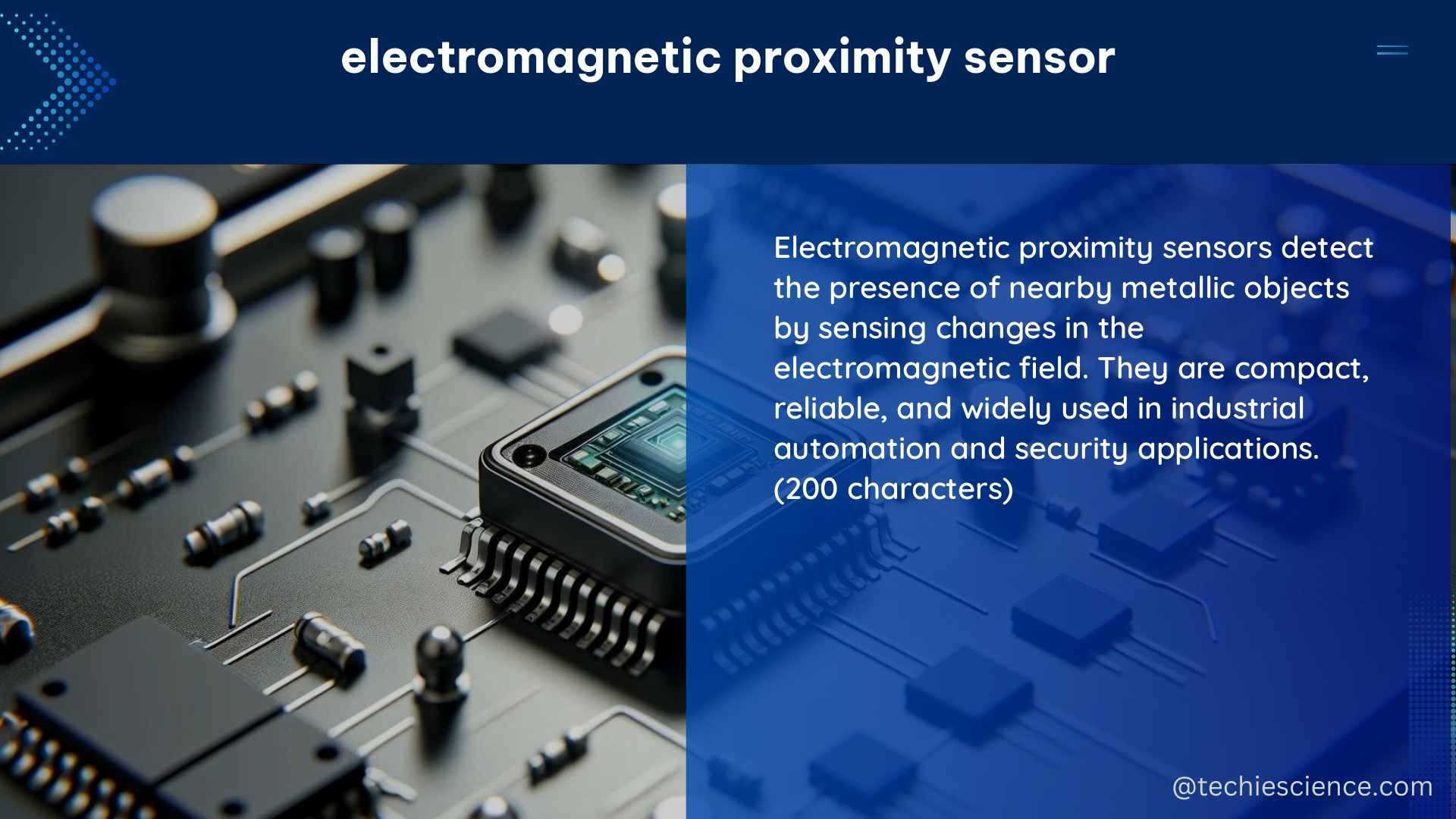Electromagnetic proximity sensors, also known as inductive proximity sensors, are non-contact sensing devices that use an electromagnetic field to detect the presence or absence of metallic objects. These sensors are widely used in industrial automation, robotics, and various other applications due to their reliability, precision, and versatility.
Understanding the Components of an Electromagnetic Proximity Sensor
An electromagnetic proximity sensor consists of four major components:
- Ferrite Core with Coils: The ferrite core with coils is the heart of the sensor, responsible for generating the electromagnetic field.
- Oscillator: The oscillator creates a symmetrical, oscillating magnetic field that radiates from the ferrite core and coil array at the face of the sensor.
- Schmitt Trigger: The Schmitt trigger responds to changes in the oscillation amplitude caused by the presence of a metal target, adjusting the sensor’s output accordingly.
- Output Amplifier: The output amplifier conditions the sensor’s output signal, making it suitable for use by an external control unit, such as a PLC, motion controller, or smart drive.
These components are typically housed in enclosures made of nickel-plated brass, stainless steel, or PBT plastic, providing protection and durability.
The Principle of Operation

When a metal target enters the oscillating magnetic field generated by the sensor, small electrical currents (eddy currents) are induced on the metal’s surface. These eddy currents change the reluctance (natural frequency) of the magnetic circuit, reducing the oscillation amplitude. The Schmitt trigger detects these amplitude changes and adjusts the sensor’s output accordingly.
The sensor’s output is then read by an external control unit, which converts the sensor’s “on” and “off” states into usable information for various applications.
Sensor Specifications and Considerations
Electromagnetic proximity sensors are typically rated by their frequency, or on/off cycles per second. Speeds can range from 10 to 20 Hz in AC, or 500 Hz to 5 kHz in DC. The sensing range of these sensors is relatively narrow, typically ranging from fractions of millimeters to 60 mm on average, with longer-range specialty inductive sensors also available.
When selecting an electromagnetic proximity sensor, it is crucial to consider the following factors:
- Sensing Range: The distance at which the sensor can reliably detect the presence of a metal target.
- Resolution: The smallest change in the target’s position that the sensor can detect.
- Accuracy: The degree of closeness between the sensor’s output and the actual target position.
- Operating Environment: Factors such as temperature, humidity, the presence of water, oils, or chemicals, and physical vibration or shock can affect the sensor’s performance.
Maintenance and Troubleshooting
Proximity sensors require regular maintenance to ensure they continue to function properly. Factors that can affect the performance of these sensors include:
- Temperature: Extreme temperatures can cause the sensor’s components to expand or contract, affecting its accuracy and reliability.
- Humidity: High humidity can lead to condensation, which can interfere with the sensor’s operation.
- Contaminants: The presence of water, oils, or chemicals can degrade the sensor’s housing and internal components.
- Vibration and Shock: Physical disturbances can cause the sensor’s components to become misaligned or damaged.
To ensure proper sensor selection and use, it is recommended to consult the technical specifications and guidelines provided by sensor manufacturers. For example, Omron provides detailed information on the effects of tightening torque, sensor size, wiring steps, cable length, distance between sensors, and surrounding objects on the sensor’s performance.
Applications of Electromagnetic Proximity Sensors
Electromagnetic proximity sensors are widely used in a variety of industries and applications, including:
- Industrial Automation: Detecting the presence or absence of metal parts, monitoring conveyor belt movements, and controlling robotic systems.
- Automotive: Monitoring engine and transmission components, detecting the position of pedals, and sensing the opening and closing of doors and hatches.
- Packaging and Labeling: Detecting the presence of products, monitoring the position of packaging materials, and ensuring proper label placement.
- Aerospace and Defense: Monitoring the position of aircraft and spacecraft components, detecting the presence of weapons and ammunition, and controlling the deployment of landing gear.
- Logistics and Warehousing: Tracking the movement of metal-based pallets, containers, and other assets.
By understanding the technical specifications and considerations involved in the selection and use of electromagnetic proximity sensors, engineers and technicians can ensure optimal performance and longevity of these versatile and reliable sensing devices.
References:
- “An Overview of Proximity Sensors | Machine Design” (https://www.machinedesign.com/automation-iiot/sensors/article/21831577/baumer-electric-an-overview-of-proximity-sensors)
- “The Fundamentals of Proximity Sensors | DigiKey” (https://www.digikey.com/en/articles/the-fundamentals-of-proximity-sensors-selection-and-use-industrial-automation)
- “Technical Explanation for Proximity Sensors” (https://www.ia.omron.com/data_pdf/guide/41/proximity_tg_e_6_2.pdf)
- “Exploring the Different Types of Proximity Sensors: Object Detection” (https://www.dynamicrep.com/blog/exploring-the-different-types-of-proximity-sensors-object-detection)

The lambdageeks.com Core SME Team is a group of experienced subject matter experts from diverse scientific and technical fields including Physics, Chemistry, Technology,Electronics & Electrical Engineering, Automotive, Mechanical Engineering. Our team collaborates to create high-quality, well-researched articles on a wide range of science and technology topics for the lambdageeks.com website.
All Our Senior SME are having more than 7 Years of experience in the respective fields . They are either Working Industry Professionals or assocaited With different Universities. Refer Our Authors Page to get to know About our Core SMEs.